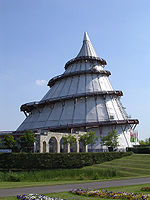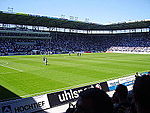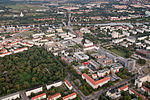Magdeburg (German: [ˈmakdəbʊʁk] (listen); Low Saxon: [ˈmaˑɪdebɔɐ̯x]) is the capital of the German state Saxony-Anhalt. The city is situated at the Elbe river.Otto I, the first Holy Roman Emperor and founder of the Archdiocese of Magdeburg, was buried in the city's cathedral after his death. Magdeburg's version of German town law, known as Magdeburg rights, spread throughout Central and Eastern Europe. In the Late Middle Ages, Magdeburg was one of the largest and most prosperous German cities and a notable member of the Hanseatic League. One of the most notable people from the city is Otto von Guericke, famous for his experiments with the Magdeburg hemispheres.
Magdeburg has been destroyed thrice in its history. In 1207 the first catastrophe struck the city, with a fire burning down almost the entire city, including the Ottonian cathedral. The Catholic League sacked Magdeburg in 1631, resulting in the death of 25,000 non-combatants, the largest loss of the Thirty Years' War. During World War II the Allies bombed the city in 1945 and destroyed much of it.
After World War II, the city belonged to the German Democratic Republic from 1949 to 1990. Since then, many new construction projects were implemented and old buildings have been restored. In 2005 Magdeburg celebrated its 1.200th anniversary.
Magdeburg is situated on Autobahn 2 and Autobahn 14, and hence is at the connection point of the East (Berlin and beyond) with the West of Europe, as well as the North and South of Germany. For the modern city, the most significant industries are: the Machine industry, Healthcare industry, Mechanical engineering, Environmental technology, Circular economy, Logistics, Culture industry, Wood industry and the Information and communications technology.There are numerous important cultural institutions in the city, including the Theater Magdeburg and the Museum of Cultural History.
Furthermore the city is the location of two universities, the Otto von Guericke University Magdeburg and the Magdeburg-Stendal University of Applied Sciences.










